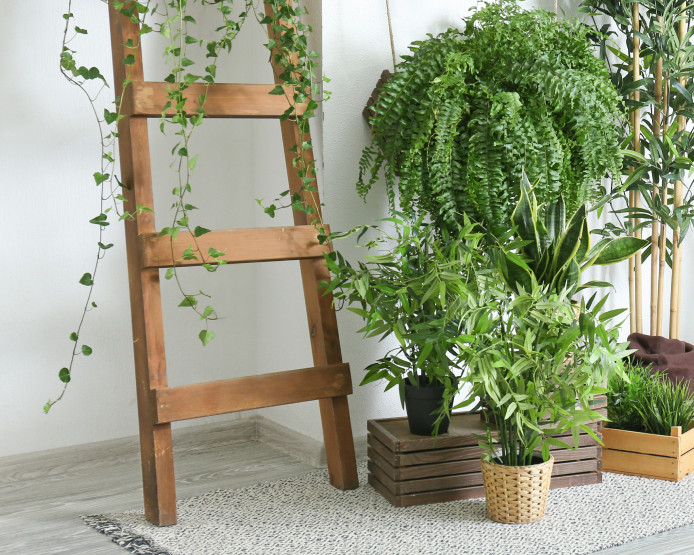Introduction
So many of the words we use when talking about inbound marketing can be easily translated into the plant world. We nurture gardens, give them rich foundations of nutrients that make them healthier, and we carefully plant to ensure everyone who wants to see and enjoy the garden has access.
When it comes to inbound marketing, we’re all growing something from seed. But our gardens will only grow if we nurture an environment that attracts growth, engages nature, and delights everyone who sees it.
Before You Plant, Plan
Setting Yourself Up for a Long Harvest
Like gardening, inbound marketing success is rooted in preparation. That’s why Jen Spencer, SmartBug’s CEO, takes the same approach to gardening as she does to inbound marketing.

When your inbound campaigns don’t have a nourishing, customer-focused foundation, they’re unlikely to grow. It’s similar to gardening. If you don’t think strategically about where to grow, and what it will take to make each plant flourish, you won’t have much success. Think of your CRM data like your seedlings, needing specific care and attention to get you the results you need.

Jen Spencer
CEO, SmartBug
In other words, you can't just throw down some seeds, walk away, and hope for the best—at least not if you want to see new growth. Before your marketing-generated revenue can bloom, you need to start with the right plan to ensure you're setting yourself up to flourish. When it comes to inbound marketing, that means understanding what it is and isn't, as well as the tools and approach necessary to see lasting results.
Learn the method behind the maturation.
Some people just seem to have a green thumb while others are lucky to keep a plant alive for a week. But the reality is, there's no magic involved in successful gardening, just like there's no magic involved in successful inbound marketing. Success in these areas is a science, and anyone can master it.
There's a method to the madness, both in gardening and in inbound marketing. Learning about the inbound methodology—how an organization grows by building meaningful relationships with people, prospects, and customers—will help you craft a strategy that gives buyers exactly what they need, when they need it.
The inbound methodology can be applied in three ways, or stages:

Attract
Draw in the right people with valuable content and conversations that establish you as a trusted advisor with whom they want to engage.

Engage
Present insights and solutions that align with their pain points and goals so they are more likely to buy from you.

Delight
Provide help and support to empower your customers to find success with their purchases.
Know what hardware the job needs.
Think of the right tools you need for your project—some jobs call for a backhoe, while others need a simple spade or shovel. A laptop or tablet may suit all of your needs, or if your content is super visual, you may require a huge monitor.
None of those gardening tools matter without a solid foundation to let your content blossom. Borders, soil, fertilizer, and pots or containers are like marketing platforms for inbound. Sometimes you need a pot or container for a simple email platform versus larger borders for robust marketing software.
Get the know-how to maintain your garden.
You need the right know-how to maintain your garden (or your inbound marketing strategy) over time. That means not only knowing and implementing the must-haves, but also knowing how to avoid the must-nots. Inbound marketing is focused on solving problems and pain points by developing engaging, relevant content for your audience.
Inbound marketing is not about:

Selling: It’s about identifying and solving real problems, not about convincing people that they need a solution to a problem they don’t have.

Interrupting: Content that’s interruptive is intrusive and annoying. Rather than interrupting potential leads, think about what you can do to engage them.

Overwhelming: Don’t inundate and overwhelm people with content. Just as overwatering is a sure-fire way to kill your plants, overwhelming is certain to kill your momentum. Instead, utilize segmentation to ensure relevant content is being delivered to the right people at the right times.

GARDENING TIP
Overwatering is one of the most common causes of plant death. Roots need water to grow, but they also need air—something they can't access if they're drowning. If your plant's leaves begin to turn brown, wilt, and feel soft and limp to the touch, it's likely a sign that you're overwatering. On the other hand, brown, wilting leaves that are dry and crispy are likely being underwatered. It's all about finding the perfect balance for your plants and conditions.
Seed Between the Lines
Learning About Your Buyer’s Journey
Growing a relationship with each buyer is like growing a plant from a seed. It takes care, planning, and a deep understanding of what the seed needs to grow. Consider the asparagus fern. Although the plant is often seen in hanging pots and window boxes, it’s deceptively picky about its environment—kind of like your buyers.
So many factors come into play when taking a fern from a seed to a healthy, thriving plant, or a buyer from one stage of their journey to the next. The plants in your garden need the right amount of water, light, nutrients, and space to grow at the stage they’re in, and your buyer’s journey is no different.
That’s why it’s crucial to understand your buyer’s wants and needs, so you can empower them to accomplish their goals at any stage of their journey.

GARDENING TIP
As potted plants grow, they may occasionally become root-bound and need to be repotted into a larger container with more breathing room. Some sure signs it’s time to repot include roots peeking up through the soil’s surface or creeping down through the pot’s drainage holes. If water pours out of the drainage holes during watering, this can also indicate the plant needs more soil to accommodate its roots.
Awareness: Know what you sow.
Sowing your asparagus fern seeds can be a delicate venture. Thyming is everything, both with plants and with inbound marketing. You need to give yourself thyme for your seeds to germinate and attract attention.
This is like your awareness content. You can’t expect new prospective leads to immediately sprout. Feeding your audience with needs-based content is like watering a seed, growing that initial connection.
Consideration: You grow, girl.
Once you get that sprout, it’s time for a little more dirt. Give your fern sprout room to grow, and wait for it to flourish. This is like your consideration content. Your buyers are enjoying the room, looking for interesting new avenues to take, and discovering new ways to grow.
Although it may be tempting to just plop the sprout in its destination pot, resist the urge. Much like your buyers, your seedling needs time to get to know its environment before it wants to stick around.
Decision: Create lawn-distance relationships.
Now that your seedling has roots and is looking for more nourishment, it’s time to put that plant in its pot and get ready to help it grow into what it wants to be. This is like decision content. The pot, soil, fertilizer, and even placement of the plant are all like your decision-level content.
Watering needs to happen regularly, and at the right time, just like content delivery. Keep giving your fern—or any plant—what it needs to grow, and you’ll develop happy, thriving lawn-distance relationships.
All Dressed Up and Nowhere to Grow
Developing Buyer Personas
Your buyers are kind of like the care cards nurseries add to plants. The cards give you everything you need to know to help them thrive.
Don’t be the person who doesn’t read the care card and brings home trays of budding beauties only to leave them languishing in their tiny nursery containers. And don’t be the person who just wants their garden to be pretty but doesn’t understand the difference between plants that shimmy in the shade and blooms that burst into beauty under the rays of full sun.
Instead, mind your care cards. Do your homework to determine the size of your garden, decide which plants need to go where, and learn about the specific care they require. Similarly, you need to understand your buyer personas, including the unique pain points, preferences, and other factors that should inform how you effectively attract, engage, and delight them.

GARDENING TIP
If you fall in love with a certain plant you spot on vacation, think twice before you buy one for your own yard or garden. Check to see which hardiness zone(s) the plant is known to flourish in and whether that includes where you live. These zones are determined by climate, with warmer temperatures having higher zone numbers. If a plant is hardy up to a certain zone number, that means lower-numbered zones will be too cold for the plant to thrive.

Don’t be the person who doesn’t read the care card and brings home trays of budding beauties only to leave them languishing in their tiny nursery containers.
Learn more about buyers’ pain points and preferences:

Clear the weeds. You might know a lot about your buyers, but if you don’t know their needs and pain points, how can you offer them solutions? You have to know what your audience really needs—everything else is just weeds that can impede your growth.

Consult a master gardener. If you’re serious about your garden, consult a master gardener—meaning, get valuable intel from your sales team and use it to inform your strategy. Your sales team has the inside information you need to give your plants (or in this case, your customers) what they need.

Find the best mixture for your turf. To find out exactly what best fertilizes your garden, ask the experts: your customers. What do they need from you before they can grow? Everything you need to know to create the best soil that allows customers to grow can be found in conversations with them.

Dig deep(er). Do your due diligence by analyzing your database to see who is consuming your content and what topics resonate with them most. Bring them solutions. If you planted mint in a dry, sunny place with no water, your mint plant won’t get very far. But plant it with a little shade and plenty of water, and your plant will get a lot of encourage-mint.
Weeding is fundamental. Weed out the bad to help the good shine. Stop producing content that just sucks up space, and start giving your buyers real news they can use. The more you know about what makes your buyers bloom, the better you can target your content to meet their needs.

Learn which plants need special care. It’s important to know which plants—or customers—require special care. Although some plants can grow under low light and with very little supervision, others have special needs, like more frequent pruning or a little extra room.

Mind the bugs and worms. When you dig in and start really asking questions, you might turn over rocks that reveal a surprising array of bugs and worms—but don’t be freaked out! Bugs and worms, like criticism, are an important part of your garden ecosystem, and they actually work for you, not against you. Take your customer feedback—the good, the bad, and the ugly—and use it to create content that really resonates with your buyer.
I’m Sexy and I Grow It
Creating Inbound Marketing Strategies
Every great gardener knows that strategizing is part of the process. Your plant care strategies will change based on what you need from the plant, and the same goes for your inbound marketing strategy.
Just like you need a plan for your garden, you need to create effective inbound marketing strategies to properly execute campaigns and achieve success—and it starts with talking about your needs and asking the right questions.
After all, there are several factors to consider: Which plants do you like? How do you know how big you want your plants to get? What do you need from the plant? Are you brightening up a room? Adding to a larger garden? Growing a showpiece?
Much like the majesty palm tree—which can be anywhere from 10 to 98 feet tall depending on how you care for it—your inbound marketing strategy can take on many different shapes and sizes. Both your plant care and inbound marketing strategies will change based on your needs and which stage of growth they’re in.
Different inbound marketing strategies can be implemented at each stage of the buyer’s journey to attract, engage, and delight potential leads.
Strategies That Attract
First and foremost, you need to help people find your garden in a sea of greenery. Attract new visitors to your website by:
Optimizing existing content: Target keywords related to your business, as well as the challenges your customers face. Then, use the keywords to optimize existing content for SEO so that it reaches more people.
Create and publish new content: Blog articles, social media posts, and content offers such as e-books or case studies are a great way to provide valuable information for your website visitors.
Gate premium content offers: Gated content can help you collect contact details that you can use to engage leads during the next stage of the inbound methodology. Just imagine the landing page and form are like garden gates that invite visitors to come inside and explore.
Adopt paid search strategies: Sometimes, even the best gardeners use plant food. By using paid search, you can pay to have your website show up at the top of a search results page and give your new inbounding marketing strategy a gentle push in the right direction.
Strategies That Engage
The next stage is all about engaging your visitors to keep them around. You can engage them with:
Email marketing to reach your target audience directly, delivering relevant and informative content straight to their inbox. (Once you start engaging via email, don’t stop; this applies during the delight stage, too.)
Lead management, or a set of methodologies and systems that use various marketing tools, campaigns, and programs to generate and nurture leads. Much like propagating plants, you can use lead nurturing to grow something new from what you started with, and build off of your success from there.
Marketing automation to streamline marketing activities and multifunctional campaigns across numerous channels and reach more people.
Conversion rate optimization, which focuses on increasing the number of visitors to a website who then take a desired action—in other words, convert!
Strategies That Delight
And last but not least, we have the delight stage—because even the happiest plants still need to be nurtured in order to grow big and strong. You can provide delight by using:
Attribution reporting can show you the impact of your marketing strategies, allowing you to make changes and optimize over time.
Spontaneous outreach can be effective during the delight stage when it comes in the form of discounts, promotions, or—best of all—free gifts!

![]()
GARDENING TIP
Did you know that you can use your plant cuttings to “propagate” or grow new plants? Start by making a clean cut from a healthy plant. Remove the lower leaves to avoid draining any moisture necessary to grow roots. Then, give your plant cutting a new (temporary) home in a jar of water and watch the roots begin to form.
PRO TIP
You can also add a rooting compound to stimulate growth!
Not-So-Secret Garden
Executing Effective Inbound Campaigns
Think of your premium inbound content like a beautiful tree. Maybe it’s a mighty evergreen that has withstood the test of time or a young, growing maple. Although each tree is unique, trees are so commonplace in many cases that they can easily go unnoticed. That’s fine if you want to simply enjoy the beauty of nature, but if you want your tree to stand out to other people, you need to draw attention to it with the right landscaping features.
In the world of inbound marketing, this looks like using effective inbound campaigns to attract people to your premium content and central messaging. These content pieces should be focal points. So, how can you highlight these focal points in your not-so-secret garden?
Throw some shade ... in a good way.
When it comes to gardening, you can use landscape features to surround your trees. A shade garden is an ideal way to add a pop of color to really set off your arboreal attraction. Plants like azaleas, hydrangeas, and mountain laurel are perfect choices that thrive in the shade and will create a beautiful border for your trees.
You can also add hard landscape features like brick borders and river rocks to highlight your trees. Bird feeders and ornamental objects can all serve to further draw the eye to your favorite focal point in the garden. Want to make these shrubby showpieces even more distinct in your garden? Create a pathway of paver stones leading to the base of the tree and install a bench.
Reap the rewards on premium content.
In inbound marketing, these attention-grabbing features include conversion paths, social posts, videos, blog calls to action (CTAs), and more. Think of these campaigns as the pathways that lead people to your content and the shade gardens that add color to draw people in to take a closer look at your premium content offers.
Especially if you already have some great premium content such as an e-book, infographic, or webinar, why not take advantage of the low-hanging fruit and focus on getting more traffic out of these existing assets? With the right campaigns, a piece of content that didn’t seem valuable at first may just prove to be a late bloomer.
As you grow your content library, you can create new pieces of premium content and new campaigns to maximize the visibility and effectiveness of these pieces. Let’s look at the practical tools you can use to execute those campaigns.

GARDENING TIP
In nature, shade plants often crop up along the banks of rivers and streams because most of these plants thrive in relatively wet conditions. While you can plant a shade garden far away from any water features, it’s smart to keep shade gardens well watered. As always, check the care instructions for any specific plants you include in your shade gardens to ensure proper watering.
Organize Your Gardening Shed
Using Inbound Software Wisely
No gardening guru is going to be careless with their gardening shed, right? Maintaining, caring for, and upgrading your tools is essential, both in gardening and inbound marketing. Choosing and maintaining the best shed for your tools is a must for growing your garden and your inbound strategy.

GARDENING TIP
The tools in your shed need ongoing care. Wipe down your tools after each use and keep them in a dry place rather than leaving them outside to avoid rusting. At the end of the season, apply a layer of oil to your tools to protect their surface. You should also oil and sharpen tools like pruning shears as needed to keep them in tip-top shape.

Choose the right plants for your environment.
Be keenly aware of your environment to ensure you’re using the right kind of software for your inbound marketing needs. Be leery (but open-minded) about the software you choose; new innovations are great, but just like with gardening, sometimes keeping it simple, well-organized shed is the best approach.
For example, just because aquaponics exists doesn’t mean you need to use it in your backyard. A complex system like this might make sense for certain operations, but maybe you just need to take your old-school garden to a wall. It all depends on your unique environmental needs, both long- and short-term.
Be thoughtful about choosing what works for you, whether that’s simple SAAS marketing automation, or a full platform of marketing, sales, and customer relationship management (CRM) tools.
Leave enough room in the shed for new tools.
Much like you need to give your plants room to grow and leave space for new plants in your garden, considering the future of your inbound marketing needs is critical. That’s why it’s important to choose inbound marketing software that will meet your current needs while also allowing you to scale for growth.
Make sure you can update, upgrade, and add to your shed over time as you expand your garden and learn new ways to help them grow. Plus, if you realize that your old tools aren’t cutting it anymore, it’s time to get honest with yourself about trading them in for some that do. Occasionally we outgrow what was once a fit, and that’s perfectly fine—and sometimes necessary to avoid remaining stagnant.
Sprout New Leads on Every Path
Nurturing Inbound Success
Gardeners and self-proclaimed plant parents know all too well that nurturing new growth and actively tending your garden is critical in order to keep it healthy and thriving. (After all, even the best gardeners need to prune sometimes.)
The same can be said for inbound marketing. When your efforts start paying off in the form of growth and conversions (or should we say sprouts and buds), don’t stop there; use the opportunity to identify new ways to optimize and enhance your inbound marketing strategies.

Ready to Grow More Efficiently and Bear More Fruit?
It’s Time to “ABMify” Inbound.
Planting the seeds and watching inbound strategies grow is certainly inspiring, but what if you’re ready to tend your marketing garden a little more efficiently? As we all know, some efforts show more return than others, and when resources get tighter or expectations get higher, you’ll want to get a bit more strategic about where you’re investing your budget (or, shall we say, about which plants you water).
Simply put: What if your garden could bloom 10 times faster with just a little more focus? In theory, it’s great to water every plant that comes your way. But sooner than later, you’ll realize that being more selective with your time and energy is a win-win for everyone. That’s why inbounders are starting to latch onto account-based marketing (ABM)—it takes the best of what they’re doing today but adds a degree of precision, which leads to more ROI. That’s why companies moving toward ABM see 99 percent better engagement, 80 percent higher win rates, and 73 percent bigger deal sizes.

We’ve always believed that taking an account-based approach is arguably even more important for growing teams with more resource constraints. Something really magical happens when you add the foundation of HubSpot’s inbound marketing to RollWorks’ highly-targeted ABM capabilities. Now companies of all sizes have a very quick and easy way to start executing and immediately see value from ABM—no matter where they are in their journey.

Randi Barshack
CEO, RollWorks
Why wouldn’t you want growth like that? If someone could tell you which plants would thrive in your environment—grow biggest and bear the most fruit—would you give other plants the same amount of water and attention? Of course not! You would rightly focus on the plants with the highest chance of success. By taking all the great things you’re doing with inbound (e.g., creating stellar content, focusing on the full lifecycle, building social awareness) and combining them with ABM, you can target the best-fit, in-market accounts so you only get the best leads with those efforts rather than sitting and waiting for them to come to you.
And the good news is that you can use most of the channels you’ve already started working with (plus a few more sprinkled in), yet only target audiences that are the best fit for you. We’re talking about “ABMifying” SEO, email, ads, chat, e-gifting, sales outreach, and more. Think of this process as creating a more curated garden. You can give the right plants much more love so that they’ll grow stronger and stick around much longer—and, of course, give you far more in return (yes, that means revenue.)


DON'T WORRY
You don’t have to go it alone. With RollWorks, you can find a path to ABM that grows with you—no matter what condition your garden is in. From small companies to large, from manufacturing to SaaS, from sales-led to PLG, RollWorks’ ABM platform helps you get where you need to grow.




